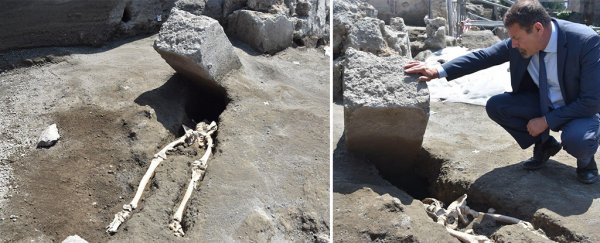Pompeii is famed for its ruins containing the remains of citizens preserved in the ash from the eruption of Mount Vesuvius in 79 CE. But a spectacular discovery is a grim reminder that heat and suffocation aren't the only ways a volcano can threaten lives.
Archaeologists have uncovered the bones of a man crushed by a 300-kilogram (661-pound) rock. It hit his torso with tremendous force, possibly decapitating him, as his skull is yet to be found.
Images released by the Italian Ministry of Cultural Heritage and Activities and Tourism show the bottom half of a skeleton extending out from underneath the large stone, probably a piece of masonry.
The victim, authorities said, was a male over the age of 30, and probably trying to flee the violent volcanic explosion. At around 8 kilometres (5 miles) away, the eruption of Vesuvius would have sent a barrage of seismic shockwaves and pyroclastic surges through both Herculaneum and Pompeii.
The ground tremors could have caused the falling of masonry, but Pompeii officials also pointed out that the stone could have been "violently thrown by the volcanic cloud."
The skeleton also displayed one other notable feature: his bones showed he had an infection in his tibia, which means he would have had difficulty moving, and was possibly disabled.
The "exceptional" find, said Pompeii Archaeological Park director general Massimo Osanna, was similar to another disabled victim of the volcano who was found not long ago.
"Beyond the emotional impact of these discoveries, the ability to compare them in terms of their pathologies and lifestyles as well as the dynamics of their escape from the eruption, but above all to investigate them with ever more specific instruments and professionalism present in the field, contribute toward an increasingly accurate picture of the history and civilisation of the age," he said.
Volcanic activity is usually preceded by earthquakes - as was the eruption of Vesuvius - but this alone wouldn't have been enough to alarm the residents of the cities near the volcano, as it was prone to a higher-than-average level of earthquake activity.
However, the volcano had been erupting for more than a day before the pyroclastic surges that cooked the towns, and the ash that rained down, and many inhabitants were able to evacuate. (Pliny the Younger famously provided a first-hand account of the eruption, which you can read here.)
It's not terribly difficult to imagine that a man struggling to walk would also have struggled to evacuate from the city - and then struggled to flee when the situation grew dire.
How did they come to the conclusion he was fleeing? The bones were found laying on top of lapilli, fragments of rock ejected from a volcano. This means he probably survived an earlier stage of the eruption.
The remains were found in the recently discovered Alley of Balconies, an extraordinary street of grand houses with mostly intact balconies, some with frescoes retaining their original colours.
It's the latest in a series of amazing excavations just in the last few months. Others include the remains of a valuable horse in a stable with a trough, and the skeleton of a child aged 7-8 - the first child's remains discovered in decades.
The excavations are taking place as part of the Great Pompeii Project, an initiative to protect the archaeological heritage of Pompeii via a programme of excavation, conservation, restoration and maintenance.
You can see more photos of the remains here.
